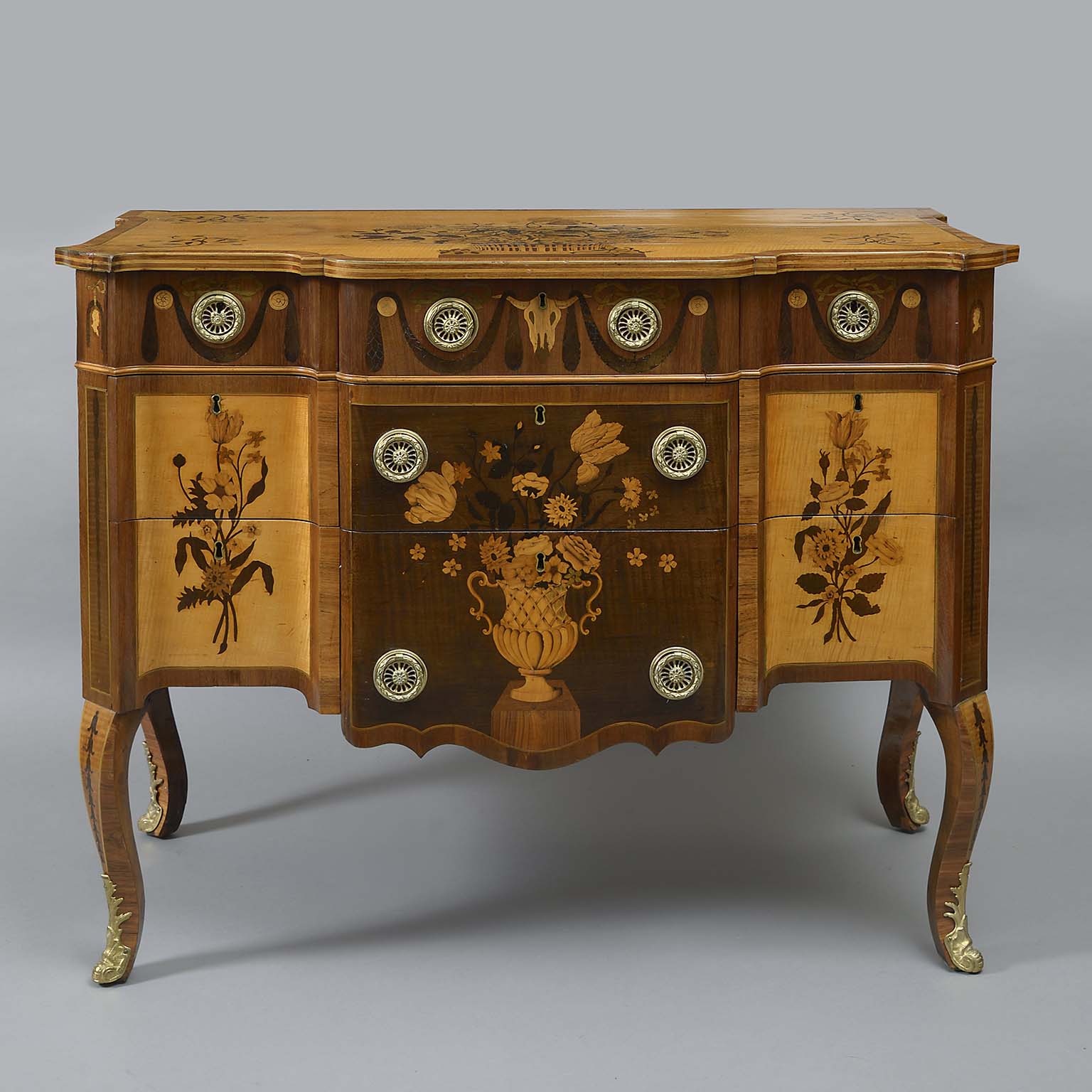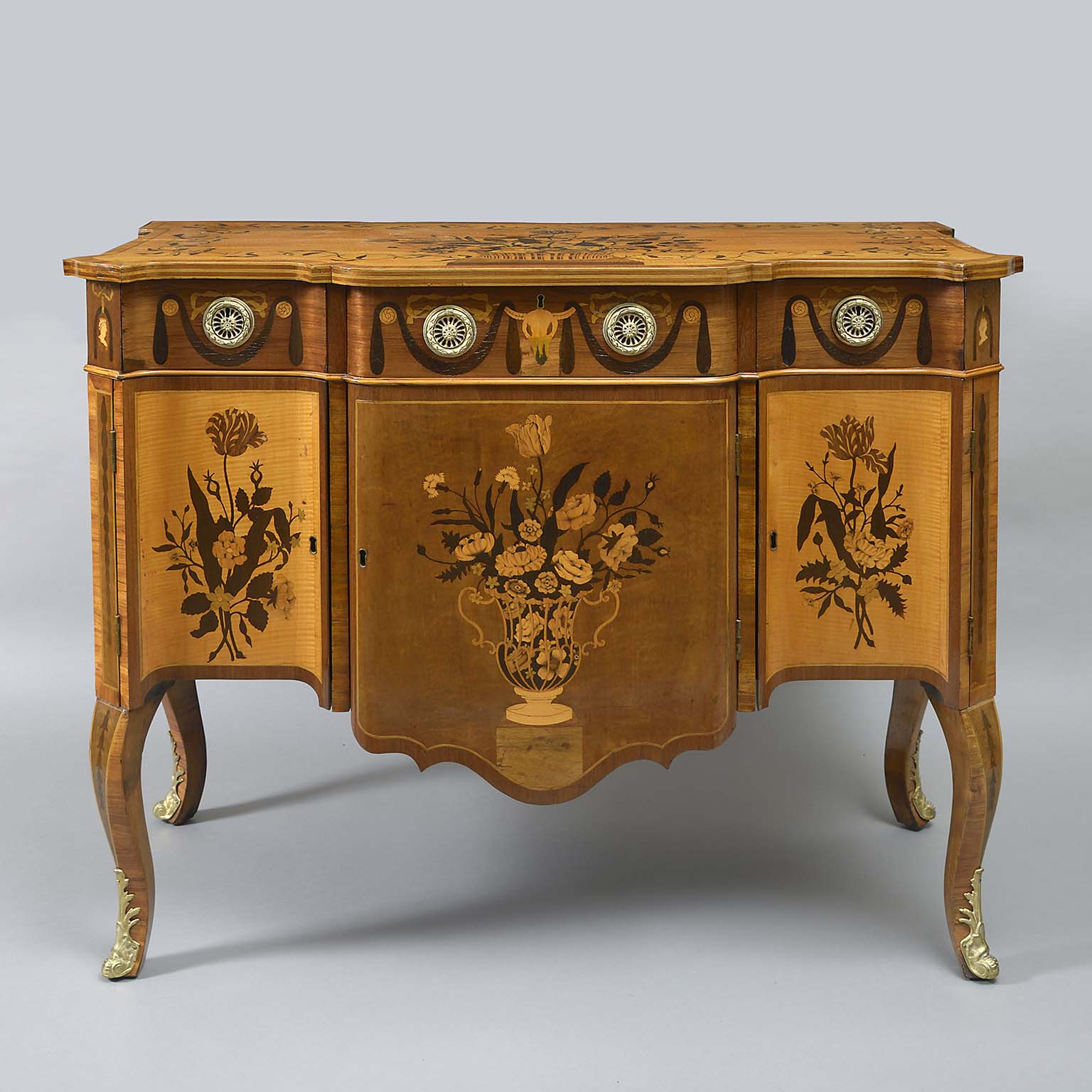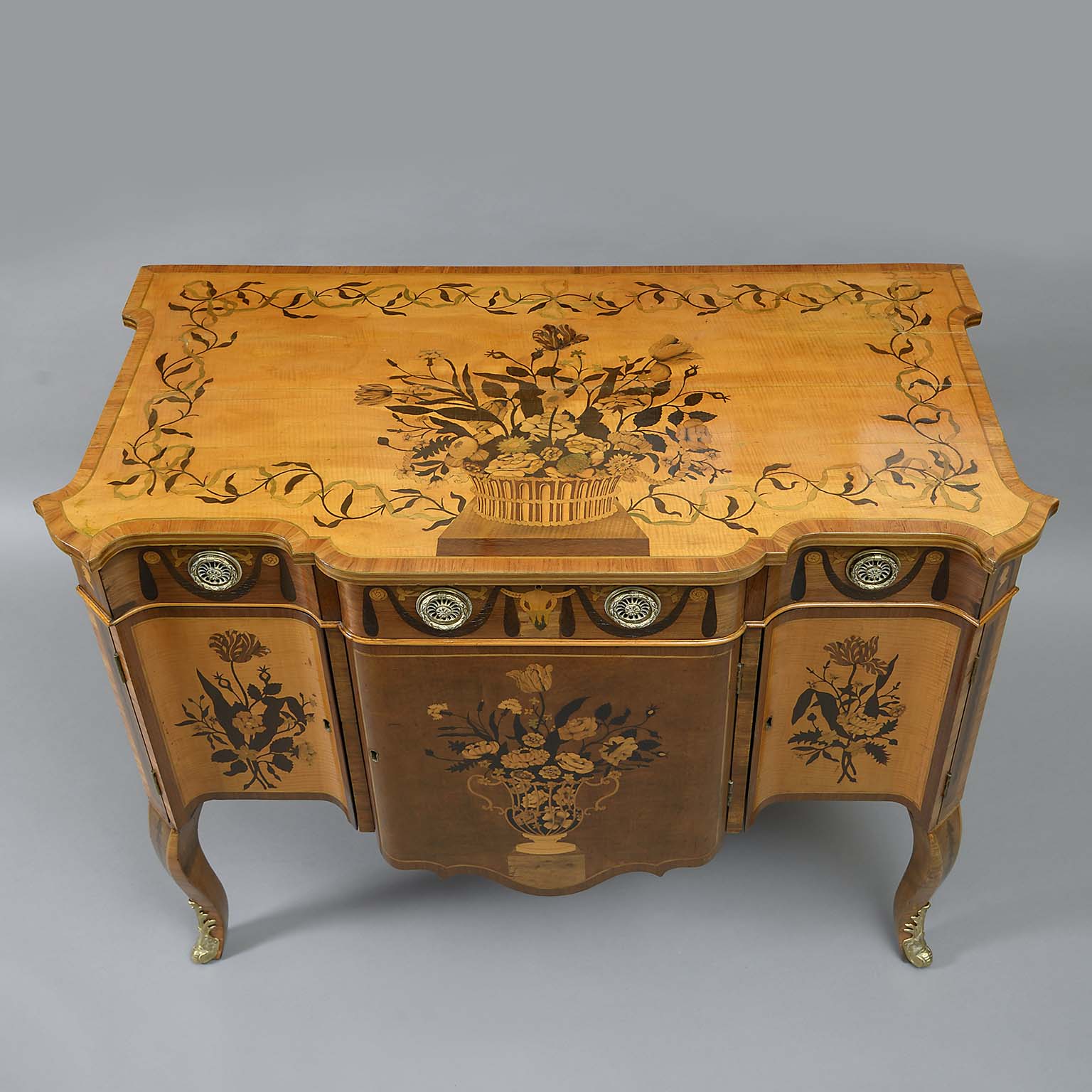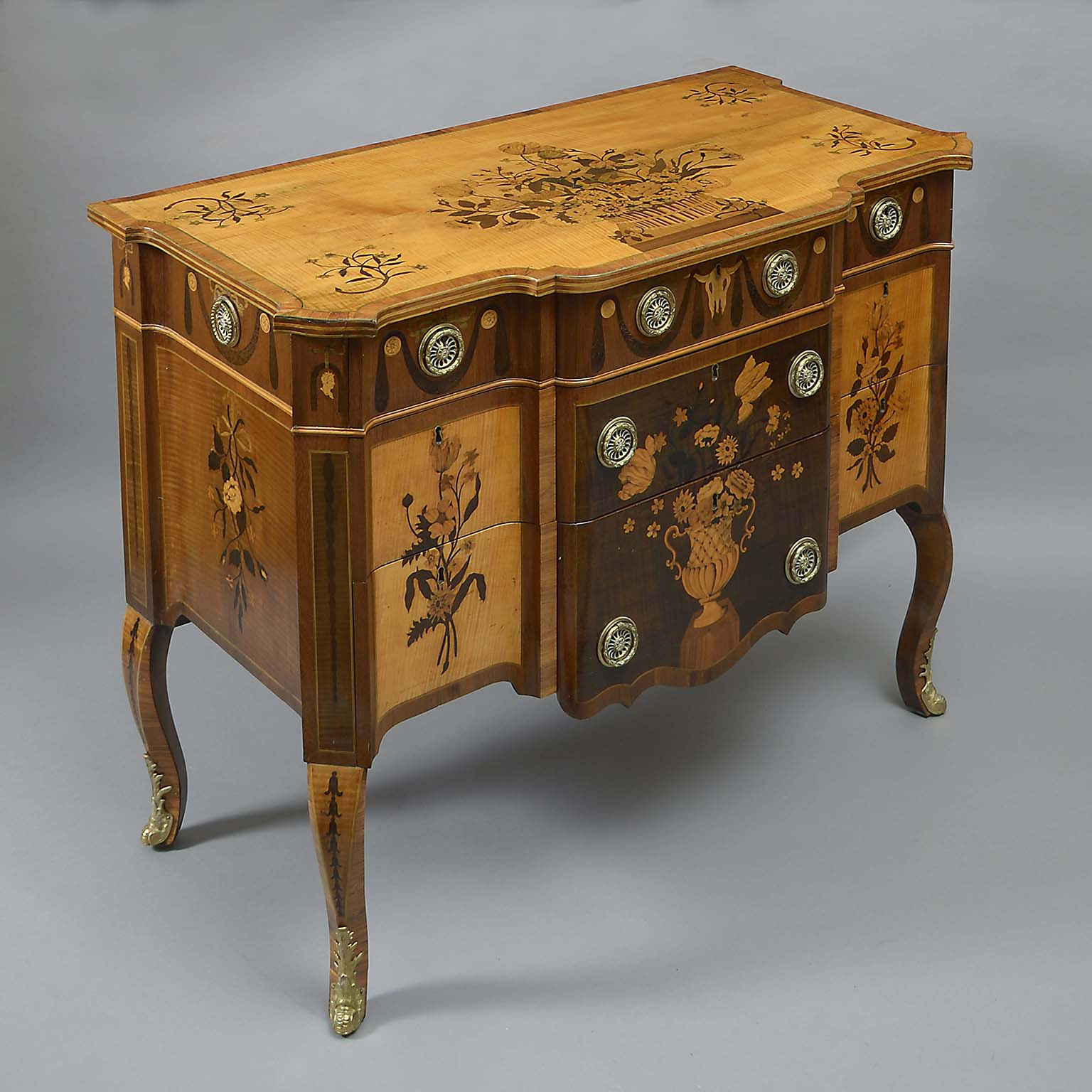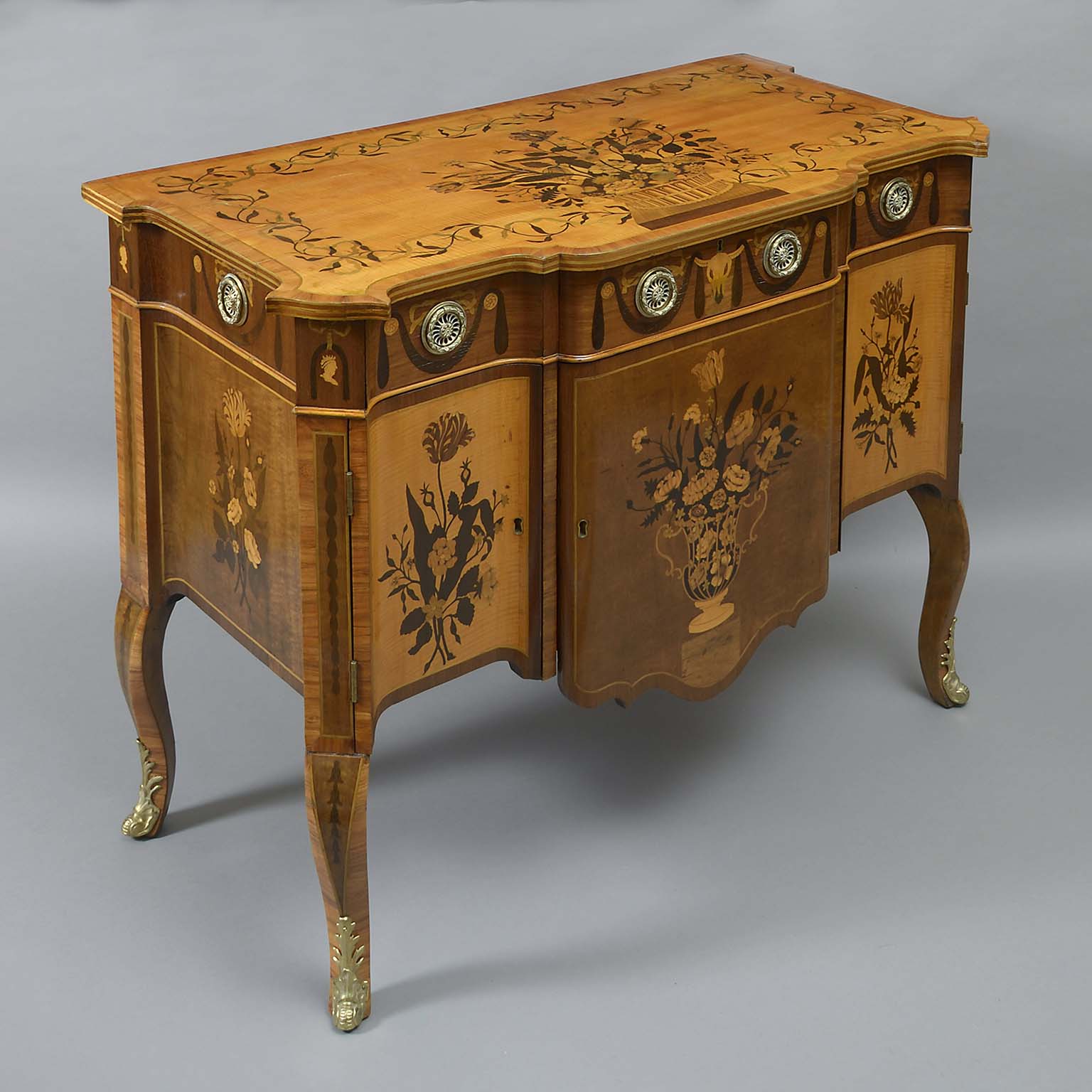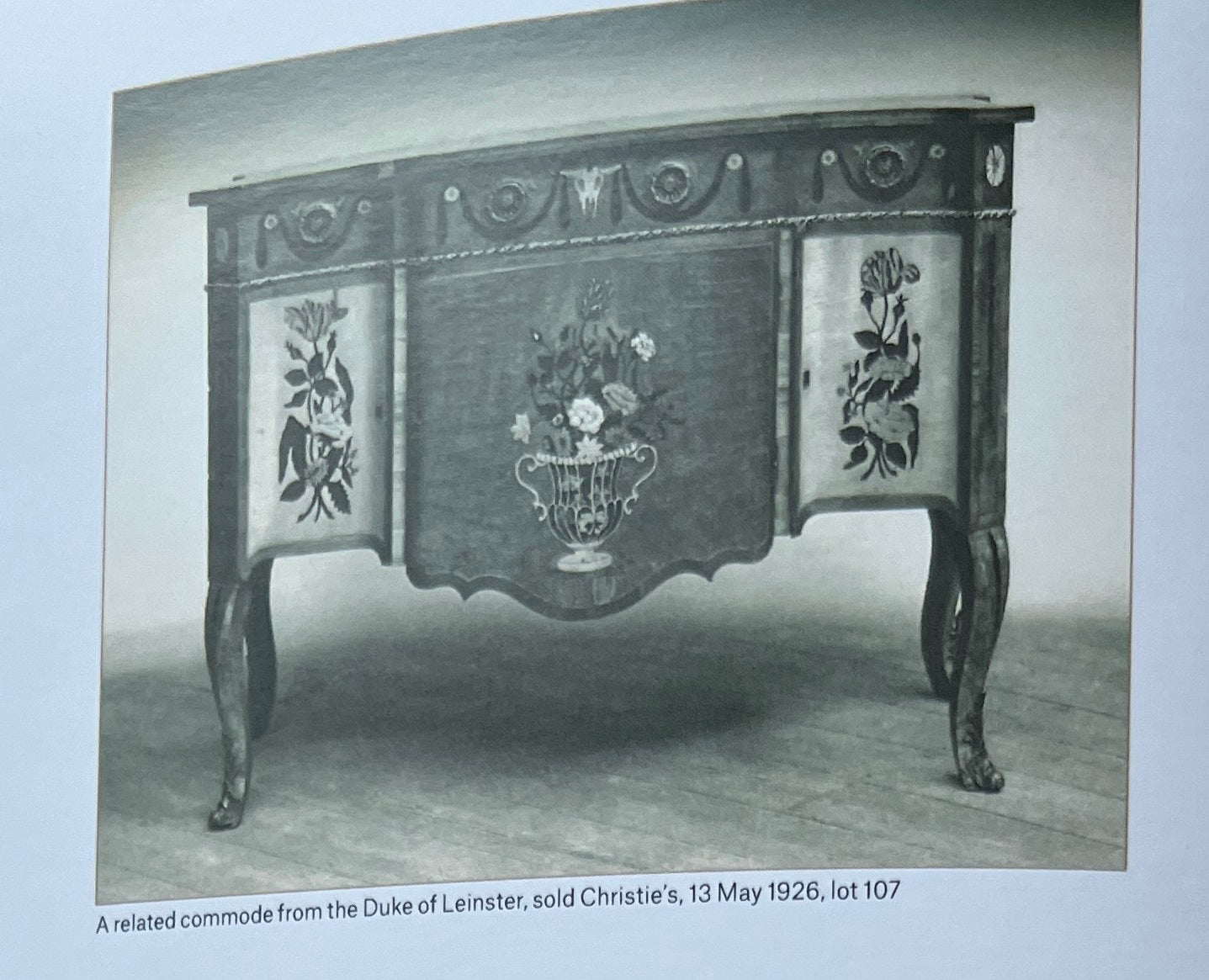AN IMPORTANT MATCHED PAIR OF IRISH GEORGE III SYCAMORE, AMARANTH AND MARQUETRY COMMODES
AN IMPORTANT MATCHED PAIR OF GEORGE III SYCAMORE, AMARANTH AND MARQUETRY COMMODES ATTRIBUTED TO CHRISTOPH FUHRLOHG AND JOHN LINNELL
CIRCA 1767/68
Almost certainly commissioned by Sir William Chambers for Leinster House, home of the Duke of Leinster.
Of breakfront outline with shaped tops and canted angles, each top centred by a large basket of flowers with ribbon-tied leafy vines or flowering sprigs, crossbanded in tulipwood, the friezes inlaid with bucrania and draped laurel garlands each with three cedar-lined drawers, the canted angles with profile medallions, the fronts both centred by flower-filled vases and with further bouquets of flowers to the side panels, one commode with six drawers, the other with three doors, the central door enclosing two mahogany and cedar drawers, on shaped cabriole legs with foliate sabots.
One 34 ¼” (87 cm) high; 44” (112 cm) wide; 23 ½” (60 cm) deep
The other: 34 ¼” (87 cm) high; 44 ¾” (114 cm) wide; 23 ¼” (59 cm) deep
Provenance:
The commode with drawers from the collection of Sir Leicester Harmsworth.
The Hon. Mrs. B.H. Burns, sold Sotheby’s London, 5 April 1963, lot 186.
The matched pair, sold anonymously, Christie’s, London, 8 July 1971, lot 117.
Acquired for an important family collection on the advice of John and Helena Hayward.
By descent
These neoclassical commodes are designed in the French ‘Antique’ style, each of slight breakfront outline and with a central ‘tablet’ to the façade. They belong to a group of commodes of almost identical form, all with similar trompe l’oeil floral marquetry, metalwork and distinctive cabriole legs, and which collectively suggest an Irish origin. The form however is also associated with the Swedish cabinet makers who settled in London via Paris in the late 1760s, the foremost being Christopher Fuhrlohg and Georg Haupt. Lucy Wood offers a detailed analysis of the commode by Christopher Fuhrlohg, circa 1772, in the Lady Lever Art Gallery, formerly the collection of Lord Leverhulme (d.1925) (L.Wood, Catalogue of Commodes, London 1994, no 9, pp.106-115 and colour of 11) and another in the Lady Lever Collection (op.cit.,no.13,pp 141-147 and colour pl. 19). She also identifies a sizeable group of commodes which all share the same distinctly French form and character, including a commode from Stanmer Park, Sussex, of circa 1773 (. p. 129, figs 124-125), another from Ham House (130, fig 126) and noting the ‘subsidiary group’ with Irish connections (. p. 130 note 12).
One of these ‘Irish’ commodes was sold from The Collection of the Duke of Leinster at Carton, Maynooth, Christie’s, London 13 May 1926 lot 107, another, with the trade label of the 19th century Dublin cabinet-maker, upholsterer and dealer ‘P.J. Walsh & Sons’ of 20, Bachelor’s Walk, Dublin, sold Christie’s, London, 21 May 1970, lot 113; another sold by an Irish family, Christie’s London, 11 November 1999, lot 160.
SIR WILLIAM CHAMBERS
Born in Gothenburg in 1723 to a Scottish father was a leading British architect. In 1755 he moved to London where he was appointed architectural tutor to the Prince of Wales and later along with Robert Adam, architect to the King. He published Treatise on Civil Architecture which dealt with the use of classical orders and included ideas from the works of many Italian 16th and 17th century architects. Between 1758 and the mid 1770s he concentrated on building houses for the nobility Importantly, in 1767 he was commissioned to redecorate the expansive first floor apartments of Leinster House.
LEINSTER HOUSE
The 3rd Duke of Leinster sold the house in 1815 to the Royal Dublin Society. Later it became the seat of the Irish Parliament which it remains today.
CHRISTOPH FUHRLOHG 1740-1792
Born in Stockholm around 1740 as the 4th child of the master cabinetmaker Johan Hugo Furloh, Christoph set off on his travels as a journeyman with his friend Georg Haupt. Before arriving in London, they worked in Amsterdam and Paris. It appears that both were given employment by John Linnell at his workshop in Berkeley Square.
JOHN LINNELL 1729-1796
Linnell was in charge of one of London’s leading 18th century cabinet-makers with many important patrons. Although there are no documentary commissions, Sir William Chambers and Linnell knew each other. Accordingly, it is almost certain that Sir William would have furnished Linnell with commissions on behalf of his clients. Furthermore, Sir William would certainly shared the common ground of his Swedish upbringing with Fuhrlohg and Haupt.
CONCLUSION
Leinster House is an extensive Palladian House that could easily have required six commodes as part of the furnishings commissioned by Chambers during his redecoration of the first floor apartments of Leinster House commencing in 1767. The group of commodes with Irish connections mentioned by Lucy Wood in her Catalogue of Commodes page 130 all seem to bear the Bucranium classical motif as popularised in Ireland by Chambers. One of this group was sold from the Duke of Leinster’s collection, Carto, Maynooth, Ireland. at Christies in May 1926, lot 107. It seems not unlikely that following the sale of Leinster House in 1815 the six
Commodes could have gradually found their way into Irish collections during the 19th and early 20th centuries. These commodes bear many of the idiosyncratic features of known commodes by Christoph Fuhrlohg from which we are able to conclude that these are all by his hand.
BUCRANIA AND IRELAND
Bucranium was a popular device in Classical architecture. It was a symbol of pagan religious rites adapted to classical design and frequently used on metopes in the Doric order. In 1759 Sir William Chambers, architect, published his treatise on civil architecture. From then on this device featured on many of Ireland’s most prominent architectural masterpieces; Casino Marino, Dublin, Powerscourt, Dublin Castle Coole, Northern Ireland, Townley Hall and Castletown to name but a few.
Collections: Antiques, Furniture, Latest Pieces
Share:

